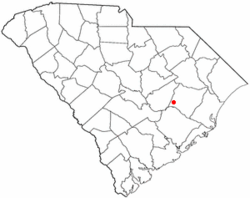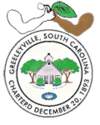Greeleyville, South Carolina facts for kids
Quick facts for kids
Greeleyville, South Carolina
|
||
|---|---|---|

Downtown Greeleyville, SC
|
||
|
||

Location of Greeleyville, South Carolina
|
||
| Country | United States | |
| State | South Carolina | |
| County | Williamsburg | |
| Incorporated | December 20, 1893 | |
| Area | ||
| • Total | 1.22 sq mi (3.17 km2) | |
| • Land | 1.22 sq mi (3.17 km2) | |
| • Water | 0.00 sq mi (0.00 km2) | |
| Elevation | 79 ft (24 m) | |
| Population
(2020)
|
||
| • Total | 384 | |
| • Density | 313.98/sq mi (121.18/km2) | |
| Time zone | UTC-5 (Eastern (EST)) | |
| • Summer (DST) | UTC-4 (EDT) | |
| ZIP code |
29056
|
|
| Area code(s) | 843, 854 | |
| FIPS code | 45-30535 | |
| GNIS feature ID | 1245822 | |
Greeleyville is a small town located in Williamsburg County, South Carolina, in the United States. In 2020, about 384 people lived there. The town was officially started on December 20, 1893.
The town's seal and flag show its first Town Hall, built in the 1890s. They also feature two arms, one black and one white, holding a tobacco leaf and a cotton boll. These symbols represent how people in Greeleyville work together and honor the town's farming past.
Every year since 1982, Greeleyville hosts a fun Flag Day celebration. It happens during Memorial Day weekend. You can enjoy bingo, street dances, delicious barbecue, and many other vendors.
Contents
History of Greeleyville
Early Inhabitants
Long ago, the area around Greeleyville was home to several Native American tribes. These included the Wee Nee, Wee Tee, and Mingoes. They used the land for hunting until the 1700s.
A group of Native Americans, called the Goins Indian Community, has lived north of Greeleyville since the mid-1800s. This was even before the town of Greeleyville existed. This community once had its own church. During the time of racial segregation, they had a state-funded school until 1949. The community is still there today. They believe they are descendants of the Wee Nee and other historic tribes from the Carolinas.
Founding the Town
Greeleyville began in the late 1800s. American Civil War veteran Samuel J. Taylor came to the area with his partner, S.J. Hudson. They bought a lot of timber land. They started making turpentine and rosin from the trees.
Three years later, Taylor bought out his partner. He then worked with his brother-in-law, W.S. Varner. Taylor was good at business. He helped the area become successful. Even after the timber was gone, he stayed in the growing town. He owned 1,200 acres within the town limits.
Taylor wanted to help the community grow. He gave land to anyone who was willing to build a home. He also freely gave land for streets, churches, and schools. The town got its name when Taylor needed an address for his store. He was a big supporter of Horace Greeley. He suggested naming the town after Greeley, and most residents agreed. There's a local story that Greeley once visited the town. He supposedly got stuck there while campaigning for president. On December 20, 1893, Greeleyville officially became a chartered town.
Growth in the 20th Century
Thomas Walter Boyle was very important to Greeleyville's growth in the early 1900s. He held many key jobs. He was vice-president of the Mallard Lumber Company. He was also president of the Bank of Greeleyville. And he led the Greeleyville Land & Improvement Company.
By 1904, Mallard Lumber Company was the town's main business. They shipped different types of lumber north to sell. Boyle's hard work in manufacturing, selling goods, and other areas helped Greeleyville grow and become successful.
Before Boyle arrived in 1886, Greeleyville was very small. It had only a saw mill, one store, and two houses. The closest school and telegraph office were miles away. But within 35 years, Greeleyville had many different businesses and industries.
Recent Changes
By the mid-1900s, many jobs in Greeleyville disappeared. This caused many people to look for work in other towns. In 1978, the town got a medical center. Four years later, in 1982, a pharmacy opened. It was built where the town's old mule and stable used to be.
The town's only chain grocery store, IGA, moved to a bigger spot in 1984. That store later closed. A Super G Foods Store opened in the same spot but closed in 2008. In the 2000s, many shops downtown closed. This was because of competition from larger stores and businesses. These larger stores were located along nearby U.S. Highway 521.
On May 21, 2021, Greeleyville celebrated a new farmer's market and pavilion. It's called the Jonte-Sabb Farmer's Market and Pavilion. It's named after Senator Ronnie A. Sabb. It's also named after Leonard Jonte, who passed away in 2008. Mr. Jonte was the former CEO of the Bank of Greeleyville. He worked hard to improve the town. He helped start the Greeleyville Flag Day Festival. He also served on the Greeleyville Beautification Committee. He even bought the Varner House, which was Samuel J. Taylor's old home. It's thought to be the oldest building in town. He opened it as a museum for historical items.
Mount Zion AME Church Fire
On June 20, 1995, Mount Zion AME Church was burned down. This was part of a series of fires at African American churches. The fire was caused by arson.
In June 1996, President Bill Clinton visited Greeleyville. He attended the dedication of the rebuilt church. He promised that the government would work to stop such fires. The church became a national symbol of hope and rebuilding after President Clinton's visit.
Historic Sites
These places in Greeleyville are listed on the National Register of Historic Places:
- The Clarkson Farm Complex
- The McCollum-Murray House
- New Market
Geography
Greeleyville covers about 1.2 square miles (3.17 square kilometers) of land. It has no water area.
Population and People
| Historical population | |||
|---|---|---|---|
| Census | Pop. | %± | |
| 1900 | 252 | — | |
| 1910 | 630 | 150.0% | |
| 1920 | 645 | 2.4% | |
| 1930 | 474 | −26.5% | |
| 1940 | 633 | 33.5% | |
| 1950 | 600 | −5.2% | |
| 1960 | 504 | −16.0% | |
| 1970 | 542 | 7.5% | |
| 1980 | 593 | 9.4% | |
| 1990 | 464 | −21.8% | |
| 2000 | 452 | −2.6% | |
| 2010 | 438 | −3.1% | |
| 2020 | 384 | −12.3% | |
| U.S. Decennial Census | |||
In 2009, there were 375 people living in Greeleyville. There were 163 households. About 36.8% of households had children under 18.
The people in Greeleyville were mostly African American (58.19%) and White (39.82%). A small number were Asian or from other races. About 2.65% of the population was Hispanic or Latino.
The population was spread out by age. About 31.2% were under 18 years old. About 12.6% were 65 years or older. The average age was 36 years.
Notable People
- Clifton Newman, a Judge in the South Carolina Circuit Court.
- Joshua Rogers, a Gospel singer who won the 5th season of BET's Sunday Best.
See also
 In Spanish: Greeleyville para niños
In Spanish: Greeleyville para niños


